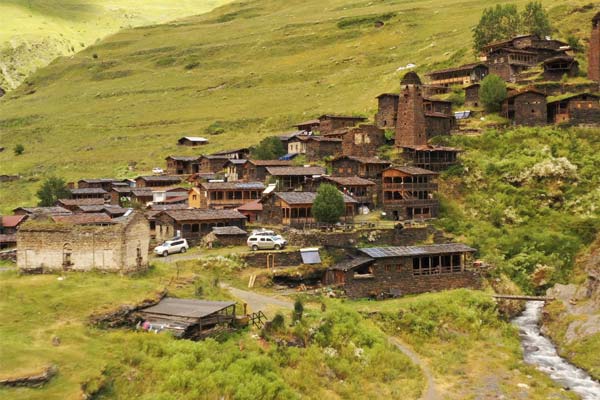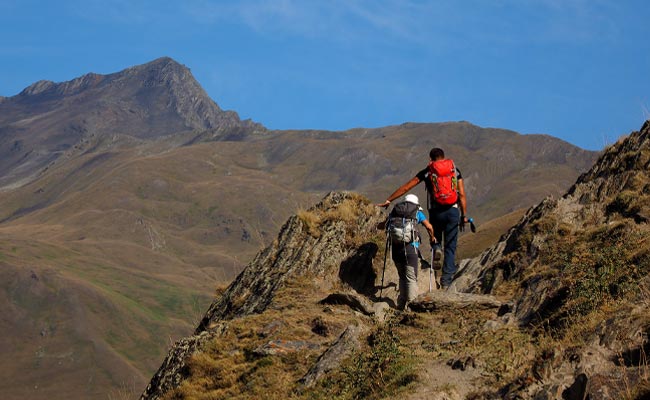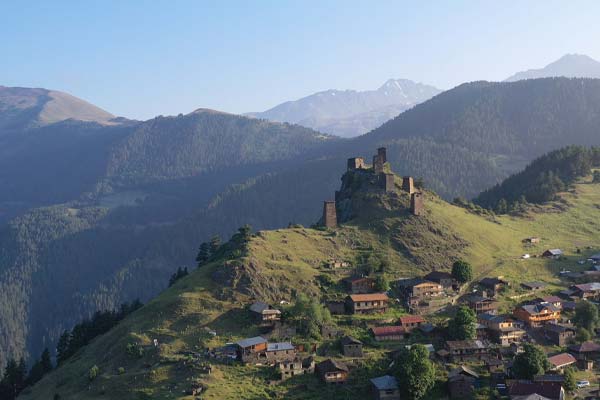|
Tusheti Tusheti is a special region not only for Georgia but for the whole world, it is one of the five most beautiful landscapes in the world and in the rating of the most dangerous roads in the world it proudly occupies the tenth place. In the 21st century, there are few areas in the world that have preserved their originality and authenticity as well as Tusheti. Untouched nature and mountainous landscapes, adventurous roads and high mountain passes, medieval towers and fortified villages, warm-hearted people and delicious cuisine - all this and much more awaits you when you plan a trip to Tusheti. Tusheti is a historical and geographical region of Georgia. It is located in the north-eastern part of the country in the Great Caucasus and borders two republics of the Russian Federation, Dagestan and Chechnya. Administratively, it is part of Kakheti. General information Area: 969 km2 Tusheti from Sky You can visit our YouTube channel and enjoy 4K footage of Tusheti History of Tusheti Numerous archaeological finds prove that people lived on the territory of Tusheti already in the Bronze Age, and already in the 3rd century BC the region became part of the East Georgian Kingdom, Kartli, known as Iberia. During the Christianisation of the country in the 4th century, Tusheti was the stronghold of pagan Georgians who did not want to accept the new religion. Nevertheless, the Tusks converted to Christianity, but 4 to 500 years later than their compatriots, but the Tusks lived and continue to live their own faith relatively independently. In the 10th century, Tusheti became part of the United Kingdom of Georgia, and for centuries the region served as an outpost against Dagestani and Chechen raids. At the same time, the region was an important strategic point in the country, from which Georgian kings were able to spread Christian culture and religion to parts of the North Caucasus. From the end of the 15th century, after the division of Georgia into three kingdoms, Tusheti was incorporated into the Kingdom of Kakheti, and as a reward the Tusks were given the winter pastures in the Kakheti valley. From the 17th century, Tusheti was an important base for the Georgian kings in their fight against the Persian conquerors, especially during the reign of Irakli II. They played a key role in the liberation of the country from the Persians and were therefore given more land in Kakheti. In the 19th century, when Georgia was annexed by Russia, the Tushes fought for a time with the North Caucasian peoples against Russian invasion, and several families from Tushetia were resettled in the Kakheti valley. During the Second World War, revolts against the Soviet Union took place in the Great Caucasus, and all the peoples, especially the Chechens and Ingush, were resettled in Central Asia in a matter of days. In Tusheti, too, many people were arrested, deported and sentenced to death during this period, but there was no resettlement of the people. It was only after the Second World War, in the 1950s, that it was decided to use the Tusheti mountains as pasture for sheep, which meant that the inhabitants were no longer able to grow grain, an important foodstuff, and the majority of the population was forced to move down into the valley. Nowadays, every Tusheti family has two houses, one in the valley of Kakheti, where they live in winter, and one in the mountains, where they spend the summer. Still, many villages are empty, especially those where there is no road, but the number of people in Tusheti is increasing every year, and tourism plays a big role, as do government subsidies. Cultural and natural highlights The whole of the Tusheti region is a scenic and cultural highlight, but if you are only visiting for a short time, you must see the fortified towers of Keselo in Upper Omalo. You should also at least go to Dartlo and take a walk around the village, which has very well restored fortified houses. The village of Parsma, just a 30-minute drive from Dartlo, is also one of the highlights of Tuscany. Traditions and festivals in Tusheti From the 19th century onwards, when the Tusheti began to leave the mountains voluntarily and often by force, many traditions and folk festivals were either forgotten or changed. Nevertheless, there are many traditions in Tusheti that are still celebrated as they were centuries ago. Atnigenoba Atnigenoba is the most important festival in Tusheti. It begins 100 days after Easter and lasts for two weeks. In pre-Christian times it was a festival in honour of the god of grain, who was also responsible for good hay and, above all, good weather for mowing. During the festival, the exact day on which the village would start reaping was decided, and those who did not abide by the decision had to pay an ox as punishment. After the Christianisation of Tusheti, the festival was associated with the martyr Athenogenes, but as a ritual Atnigenoba was and remains a pagan festival celebrated not only in Tusheti but in several countries of the Great Caucasus. Nowadays, the festival is held for two weeks in each village of Tusheti, and in each village a family is elected as the host of the festival, called Schulta, who, among other things, is responsible for brewing the sacred beer according to all religious rites. The festival is presided over by the local priest, the "Khelosani". He consecrates the beer, brings out the cross with small flags and bells, and announces the beginning of the festival to the village. Then all the villagers and guests are blessed several times and people sit around the tables, women and men separately. After the meal, regional dances and competitions begin, including horse races. Also important is the ritual of the symbolic fight between men and women, called "chataraoba". The ritual symbolises the cosmic connection of men and women with the universe and the magical creation of the earth. After Atnigenoba, the hard work begins with reaping, storing the harvest and preparing for the cold winter season. Tushetoba The festival dedicated to the regional shepherds is held every year in the administrative centre of Tusheti, Omalo. Shepherding has a very long history in the region and the importance of this very difficult work is emphasised with the festival. During Tushetoba there is an exhibition of regional handicrafts such as carpets, many hand-knitted socks, sweaters, hats, etc. There are regional dishes and concerts. Regional dishes are cooked and concerts of local folklore are held. Government officials are often present at the festival to officially thank the herders and give gifts to their families. Kod-Mekodeoba, (Brotherhood between villages) In Tusheti there is a tradition of brotherhood between villages. This tradition has helped to survive difficult times together for centuries. Brotherhood was anchored in the common brewing of the sacred beverage beer (Aludi). Recently, the Tusheti Protected Area has established a brotherhood with the Rocky Mountains National Park. Symbol of sun According to Tusheti beliefs, the sun has the nature of a woman, she sees everything, warms everyone and lights the way for everyone, no matter how good or bad they are. In the evening she goes home and tells her mother what she has seen on earth. A rider in the village Any rider wishing to pass through the village must dismount, as a sign of respect to the villagers and also as a sign that you have come in peace. Riding through the village symbolises raiding and chaos. The souls of the dead As everywhere in the mountainous regions of the Caucasus, Tusheti has a special relationship with the souls of the deceased. When people die (in Georgian it is called transformation), the soul leaves the body and goes to the spirit world. There it continues to need food and drink, festivities, horses and armour. Therefore, a feast is often prepared in the name of the deceased, and a horse and armour are also given to someone in the name of the deceased. Traditional beer of Tuschetia - "Aludi Beer brewing has a very long history in Tusheti. It was and is an important part of all religious festivals in the region and is treated with respect. The place where the beer is brewed is called "Salude", the barrel where it is stored is called "Kodi" and the beer itself is called "Aludi". The room where Tuschet beer is brewed is part of a sanctuary and, like other sanctuaries in the region, only men are allowed to enter. Shrines and general religious rites in Tusheti Inhabitants of the Tusheti region are Christian, but in reality, religion in Tusheti is a mixture of pagan and Christian, with most pagan elements being identified as Christian. For example, the liturgy is not celebrated in the church, but at the "Dzhvari" and "Khati", which are prayer shrines about two metres high, built of natural stone, usually decorated with ibex horns and often with a small bell attached. The liturgy is also not conducted by a priest, but by the "Khelosani", "Shulta" or village elder, who is elected by the village. They also perform marriage ceremonies and all religious rituals. The liturgy itself has little to do with the canonical Orthodox services, but is more like an offering in the form of an animal or food specially prepared for the day. During the offering, a special prayer is said for the saint to whom the shrine, sanctuary, etc. is dedicated. These saints also have little to do with Christian saints, but are mostly from pre-Christian times, but all Tushetian saints, angels, etc. are children of God according to Tushetian beliefs. Another important factor that distinguishes the local faith from Christianity is the prohibition of women approaching a prayer shrine. This may sound very unusual to many visitors to the region, but as a guest you simply have to accept it. Cuisine in Tusheti The cuisine in Tusheti consists mainly of three components, which are prepared in different ways, these are 1. meat, either beef or sheep After a sharp increase in sheep farming in the 20th century, cereal farming was abandoned in Tusheti, but cereal products still play an important role in the local cuisine. People of Tusheti are very familiar with medicinal plants and wild herbs, which are used extensively in the preparation of Tushetian dishes. 1. Gudis kweli - sheep's cheese, is a speciality in Georgia because it is preserved in a sack of sheepskin and has a very intense flavour. 3. Kotori - curd cheese bread. Made with yeast free dough, filled with dry curd cheese and baked in clarified butter. 4. Kalti - small dried cheese rolls made from sheep's cheese and matured in sheepskin. The most common beverage is the Tushetian malt beer called "Aludi" and tea made from various mountain herbs. Hiking routes in Tusheti Tusheti is famous for its many beautiful hiking routes. There are very easy and short walks, as well as day or multi-day walks of medium to difficult difficulty. Unlike the other well-known hiking areas of Svaneti, it is not always possible to stay in a guesthouse or other accommodation in Tusheti, as there are not always inhabited villages in the region. Permit during the trek You don't need a pass or any kind of permission to walk in Tusheti, but Tusheti is on the border with the Russian Federation and if you want to walk into the other region of Georgia, for example Chevsuretia, it is essential to get a pass from the border police. It costs nothing and is relatively quick. You can also apply for a pass online and pick it up in person at the Border Police office in Tbilisi. E-mail: bpol@mia.gov.ge Postal address: Tbilisi, 12 Kandelaki St. Border police website in English: http://bpg.gov.ge/en/symbols You should always have your passport with you for checking during the trek. The most popular trekking routes in Tusheti are: 1. from Omalo to Shatili via Atsunta Pass (about 5 days). Shepherd dogs in Tusheti There are many sheep in Tusheti, which are herded by Caucasian shepherd dogs. The dogs are not aggressive in themselves, but as soon as you approach their defensive territory, they start to do their job, and they do it very well. You don't have to be afraid, but you should avoid the flocks as much as possible, and if that's not possible, then you have to make contact with the shepherds by whistling, shouting etc. from a distance, because apart from the dogs, there are also several shepherds with the flocks. If the dogs still start shooting at you, do not run away as this will only make the situation worse. The best thing to do is to stand still and not move. In such situations it helps to have a piece of bread ready and throw it to the dogs as a good sign. Shopping in Tusheti If you're staying at a guesthouse in Tusheti, you don't need to worry about food, as every guesthouse and family hotel offers breakfast, dinner and packed lunches. However, if you are travelling with a tent, you will need to stock up in the valley, at Telavi at the latest. Up in Tusheti there are no real shops where you can buy anything, but there are small bakeries, small restaurants and so on. In other words, you won't go hungry anywhere in Georgia, not even in Tusheti, but you'll have to take care of the logistics of the trek before you get to Tusheti. No pork meat in Tusheti Although people of Tusheti are Christian, pork is not eaten in the region out of conviction. This is due to pre-Christian rituals and customs in which pork is considered an unclean animal. Tusheti lies on the border with Muslim Dagestan and Chechnya, and families from both countries have often come to Tusheti and settled there. The cultures have mixed over the centuries and this is one of the reasons why pork is not eaten in Tusheti. Other reasons are quite practical: the Tusks have always raised sheep and thus earned their living, and pork was a kind of competition for them. In addition, the Tushes go to the mountains with their animals every spring and return to the valley in Kakheti in autumn. It is certainly not easy to go up and down the mountain pastures with the pigs. As a guest, you should respect local customs and not bring any pork into the region. Road to Tusheti The road to Tusheti via Abano Pass (2,826m) is quite adventurous. According to a BBC programme, it is one of the 10 most dangerous roads in the world, but if you have a good driver and a good off-road car, you needn't worry, just make sure you don't drive up or down in heavy rain. You can't drive the road in winter anyway, because it is closed from the end of October to mid-May. There is no public transport to Tusheti, but there are private 4x4 taxis from the village of Kwemo Alwani, 25 kilometres north of Telavi, which will take you to Omalo for about 200 euros (per car). The cars are spacious and seat 4 to 6 people. Otherwise, there are many companies in Georgia that will take you from Tbilisi or any other place to Omalo and back to Tbilisi. Interesting to know The village of Bochorna in Tusheti is 2,345 metres above sea level and since 2014 has been the highest permanently inhabited village in Europe. On following trip, you will visit Tusheti Trekking Omalo - Stepantsminda >> from 1,850 EUR |






